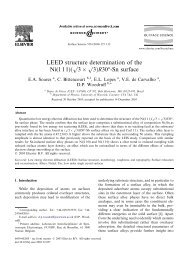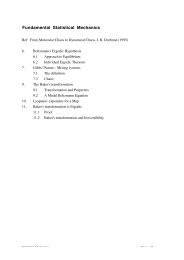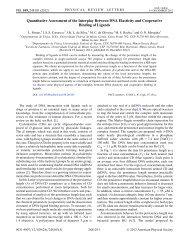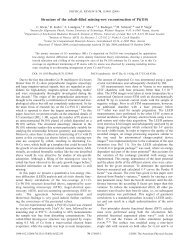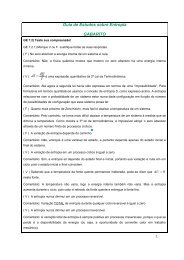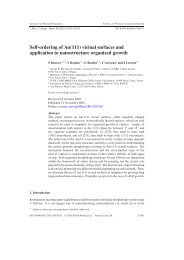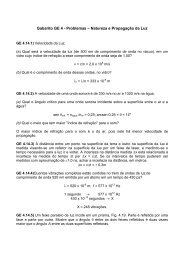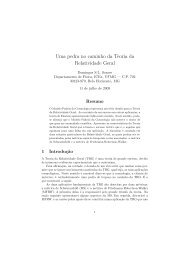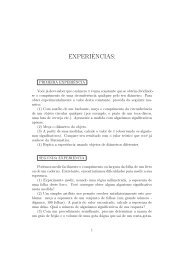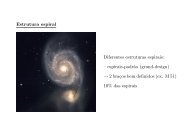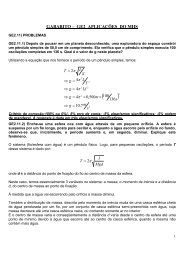Universal Quantum Criticality at the Mott-Anderson Transition
Universal Quantum Criticality at the Mott-Anderson Transition
Universal Quantum Criticality at the Mott-Anderson Transition
You also want an ePaper? Increase the reach of your titles
YUMPU automatically turns print PDFs into web optimized ePapers that Google loves.
PRL 110, 066401 (2013) PHYSICAL REVIEW LETTERS<br />
<strong>Universal</strong> <strong>Quantum</strong> <strong>Criticality</strong> <strong>at</strong> <strong>the</strong> <strong>Mott</strong>-<strong>Anderson</strong> <strong>Transition</strong><br />
M. C. O. Aguiar 1 and V. Dobrosavljević 2<br />
1<br />
Departamento de Física, Universidade Federal de Minas Gerais, Avenida Antônio Carlos 6627, Belo Horizonte,<br />
Minas Gerais 31270-901, Brazil<br />
2<br />
Department of Physics and N<strong>at</strong>ional High Magnetic Field Labor<strong>at</strong>ory, Florida St<strong>at</strong>e University, Tallahassee, Florida 32306, USA<br />
(Received 24 August 2012; revised manuscript received 30 November 2012; published 5 February 2013)<br />
We present a large N solution of a microscopic model describing <strong>the</strong> <strong>Mott</strong>-<strong>Anderson</strong> transition on a<br />
finite-coordin<strong>at</strong>ion Be<strong>the</strong> l<strong>at</strong>tice. Our results demonstr<strong>at</strong>e th<strong>at</strong> strong sp<strong>at</strong>ial fluctu<strong>at</strong>ions, due to <strong>Anderson</strong><br />
localiz<strong>at</strong>ion effects, dram<strong>at</strong>ically modify <strong>the</strong> quantum critical behavior near disordered <strong>Mott</strong> transitions.<br />
The leading critical behavior of quasiparticle wave functions is shown to assume a universal form in <strong>the</strong><br />
full range from weak to strong disorder, in contrast to disorder-driven non-Fermi liquid (‘‘electronic<br />
Griffiths phase’’) behavior, which is found only in <strong>the</strong> strongly correl<strong>at</strong>ed regime.<br />
DOI: 10.1103/PhysRevLett.110.066401 PACS numbers: 71.27.+a, 71.10.Hf, 71.30.+h, 72.15.Rn<br />
Both <strong>Anderson</strong> (disorder-driven) and <strong>Mott</strong> (interactiondriven)<br />
routes to localiz<strong>at</strong>ion play significant roles in<br />
m<strong>at</strong>erials close to <strong>the</strong> metal-insul<strong>at</strong>or transition (MIT)<br />
[1], but <strong>the</strong> full understanding of <strong>the</strong>ir interplay remains<br />
elusive. These effects are believed to be <strong>the</strong> cause of many<br />
puzzling fe<strong>at</strong>ures in systems ranging from doped semiconductors<br />
[2] and two-dimensional electron gases [3], to<br />
broad families of complex oxides [4].<br />
Early <strong>the</strong>ories of <strong>the</strong> MIT [5] focused on <strong>the</strong> stability of<br />
conventional metals to introducing weak disorder, but <strong>the</strong>se<br />
Fermi-liquid approaches proved unable to describe strong<br />
correl<strong>at</strong>ion phenomena which have taken center stage in<br />
recent years. Indeed, <strong>the</strong> last two decades have seen significant<br />
advances in our understanding of ‘‘<strong>Mott</strong>ness,’’ not least<br />
because of <strong>the</strong> development of dynamical mean-field <strong>the</strong>ory<br />
(DMFT) [6], which has been very successful in quantit<strong>at</strong>ively<br />
explaining many aspects of strong correl<strong>at</strong>ion.<br />
Because in its simplest form DMFT does not capture<br />
<strong>Anderson</strong> localiz<strong>at</strong>ion effects, several recent refinements<br />
were introduced, which proved capable of capturing both<br />
<strong>the</strong> <strong>Mott</strong> and <strong>the</strong> <strong>Anderson</strong> mechanisms. The conceptually<br />
simplest [7] such approach—<strong>the</strong> typical-medium <strong>the</strong>ory<br />
(TMT)—provided <strong>the</strong> first self-consistent description of<br />
<strong>the</strong> <strong>Mott</strong>-<strong>Anderson</strong> transition, and offered some insight<br />
into its critical regime. For weak to moder<strong>at</strong>e disorder,<br />
this <strong>the</strong>ory found a transition closely resembling <strong>the</strong> clean<br />
<strong>Mott</strong> point, while only <strong>at</strong> stronger disorder <strong>Anderson</strong><br />
localiz<strong>at</strong>ion modified <strong>the</strong> critical behavior. However, close<br />
scrutiny [8] revealed th<strong>at</strong> some of <strong>the</strong>se findings may be<br />
artifacts of <strong>the</strong> neglect of sp<strong>at</strong>ial fluctu<strong>at</strong>ions in this<br />
formul<strong>at</strong>ion.<br />
An altern<strong>at</strong>ive but technically more challenging<br />
approach to <strong>Anderson</strong>-<strong>Mott</strong> localiz<strong>at</strong>ion was dubbed<br />
‘‘St<strong>at</strong>istical DMFT’’ (st<strong>at</strong>DMFT) [9]. Here, only <strong>the</strong> strong<br />
correl<strong>at</strong>ions are tre<strong>at</strong>ed in a self-consistent DMFT fashion,<br />
while disorder fluctu<strong>at</strong>ions are tre<strong>at</strong>ed by a (numerically)<br />
exact comput<strong>at</strong>ional scheme. While certainly much more<br />
reliable than TMT-DMFT, so far this method has been<br />
week ending<br />
8 FEBRUARY 2013<br />
utilized only in a handful of <strong>the</strong>oretical studies of <strong>the</strong><br />
<strong>Mott</strong>-<strong>Anderson</strong> transition [10,11], and <strong>the</strong> precise form<br />
of quantum criticality has never been explored in detail.<br />
In this Letter, we present <strong>the</strong> first precise and detailed<br />
study of <strong>the</strong> quantum critical behavior of <strong>the</strong> <strong>Mott</strong>-<br />
<strong>Anderson</strong> transition in a Be<strong>the</strong> l<strong>at</strong>tice, within <strong>the</strong> framework<br />
of st<strong>at</strong>DMFT. We address <strong>the</strong> following physical<br />
questions, which we answer in a clear and reliable fashion:<br />
(1) Are <strong>the</strong>re two distinct types of quantum criticality in<br />
this model, as TMT-DMFT suggested, or do <strong>the</strong> fluctu<strong>at</strong>ion<br />
effects restore universality within <strong>the</strong> critical regime?<br />
(2) How general is <strong>the</strong> disorder-driven non-Fermi liquid<br />
behavior (electronic Griffiths phase), and how does it rel<strong>at</strong>e<br />
to <strong>the</strong> rel<strong>at</strong>ive strength of correl<strong>at</strong>ions and disorder? These<br />
results are obtained for a specific microscopic model,<br />
where our formul<strong>at</strong>ion proves exact in an appropri<strong>at</strong>ely<br />
defined large N limit.<br />
Charge transfer model and st<strong>at</strong>DMFT.—The charge<br />
transfer (CT) model has been used in <strong>the</strong> description of<br />
many multiband systems near <strong>the</strong> <strong>Mott</strong> transition, including<br />
various oxides [12], two-dimensional electron gases<br />
near Wigner-<strong>Mott</strong> crystalliz<strong>at</strong>ion [13], as well as doped<br />
semiconductors [14]. It consists of a two-band model,<br />
where one band represents weakly correl<strong>at</strong>ed conduction<br />
electrons and <strong>the</strong> o<strong>the</strong>r one is a narrow, strongly correl<strong>at</strong>ed<br />
band containing nearly <strong>Mott</strong>-localized electrons. In <strong>the</strong><br />
clean case, <strong>the</strong> <strong>Mott</strong>-insul<strong>at</strong>ing phase can be approached<br />
<strong>at</strong> odd integer filling by increasing <strong>the</strong> charge-transfer gap,<br />
which reduces <strong>the</strong> hybridiz<strong>at</strong>ion between <strong>the</strong> two bands.<br />
When <strong>the</strong> effective (correl<strong>at</strong>ion-renormalized) hybridiz<strong>at</strong>ion<br />
vanishes, <strong>the</strong> system undergoes a <strong>Mott</strong> metal-insul<strong>at</strong>or<br />
transition.<br />
While many studies of <strong>the</strong> <strong>Mott</strong>-<strong>Anderson</strong> transitions<br />
concentr<strong>at</strong>e on disordered single-band Hubbard models,<br />
we chose to focus on <strong>the</strong> CT model for two specific<br />
reasons. First, most real <strong>Mott</strong> systems are better described<br />
by <strong>the</strong> CT model than by <strong>the</strong> single-band Hubbard model,<br />
because it better incorpor<strong>at</strong>es <strong>the</strong> charge-transfer n<strong>at</strong>ure.<br />
0031-9007=13=110(6)=066401(5) 066401-1 Ó 2013 American Physical Society
PRL 110, 066401 (2013) PHYSICAL REVIEW LETTERS<br />
Second, <strong>the</strong> simplest version of <strong>the</strong> CT model imposes <strong>the</strong><br />
U ¼1constraint (no double occupancy) for <strong>the</strong> correl<strong>at</strong>ed<br />
band, a fe<strong>at</strong>ure th<strong>at</strong> considerably simplifies some technical<br />
aspects of our calcul<strong>at</strong>ion, allowing a simple Gutzwillertype<br />
vari<strong>at</strong>ional solution of <strong>the</strong> model. This becomes<br />
formally exact in an appropri<strong>at</strong>e large N limit, which is<br />
conveniently formul<strong>at</strong>ed within <strong>the</strong> standard slave-boson<br />
approach [15].<br />
The Hamiltonian of our disordered CT model corresponds<br />
to th<strong>at</strong> of <strong>the</strong> disordered <strong>Anderson</strong> l<strong>at</strong>tice model,<br />
which is given by<br />
H ¼ X<br />
½ð" i Þ ij tŠc<br />
ij<br />
y<br />
i cj þðEf Þ X<br />
f<br />
i<br />
y<br />
i fi þ V X<br />
ðc y<br />
i fi þ f y<br />
i ci ÞþU X<br />
nfi"nfi#; (1)<br />
i<br />
where c y<br />
i (c i ) cre<strong>at</strong>es (destroys) a conduction electron<br />
with spin on site i, f y<br />
i and f i are <strong>the</strong> corresponding<br />
cre<strong>at</strong>ion and annihil<strong>at</strong>ion oper<strong>at</strong>ors for a localized f elec-<br />
tron with spin on site i, n fi ¼ f y<br />
i f i is <strong>the</strong> number<br />
oper<strong>at</strong>or for f-electrons, t is <strong>the</strong> hopping amplitude, which<br />
is nonzero only for nearest neighbors, E f is <strong>the</strong> f-electron<br />
energy, U is <strong>the</strong> on-site repulsion between f electrons, V is<br />
<strong>the</strong> hybridiz<strong>at</strong>ion between conduction and f electrons, and<br />
is <strong>the</strong> chemical potential. Disorder is introduced through<br />
<strong>the</strong> on-site energies " i for conduction electrons, which<br />
follow a distribution Pð"Þ, assumed to be Gaussian with<br />
zero mean and variance W 2 . Throughout this Letter we use<br />
<strong>the</strong> half-bandwidth for conduction electrons as <strong>the</strong> unit of<br />
energy; <strong>the</strong> hybridiz<strong>at</strong>ion potential is chosen to be V ¼ 0:5.<br />
Within <strong>the</strong> CT model, <strong>the</strong> average number of electrons<br />
per unit cell is equal to 1, which can be enforced by<br />
adjusting <strong>the</strong> chemical potential and is written as<br />
i<br />
hn ciiþhn fii ¼1; (2)<br />
where nfi ¼ nfi" þ nfi# gives <strong>the</strong> number of f electrons<br />
on site i, nci ¼ nci" þ nci# is <strong>the</strong> corresponding number<br />
oper<strong>at</strong>or for conduction electrons, with nci ¼ c y<br />
i ci ,<br />
and <strong>the</strong> averages are taken over <strong>the</strong> distribution Pð"Þ.<br />
In this work we solve <strong>the</strong> above Hamiltonian using<br />
st<strong>at</strong>DMFT [9], in which <strong>the</strong> disordered l<strong>at</strong>tice model is<br />
reduced to a self-consistent solution of an ensemble of<br />
single-impurity models loc<strong>at</strong>ed in <strong>the</strong> different sites j of<br />
<strong>the</strong> l<strong>at</strong>tice. The corresponding local effective actions take<br />
<strong>the</strong> form:<br />
SðiÞðjÞ ¼ X Z<br />
d<br />
0<br />
Z<br />
d<br />
0<br />
0f y<br />
j ð Þ½ ð 0Þð@ þ Ef Þ<br />
þ 0<br />
fjð ÞŠfj ð 0ÞþU Z<br />
d nfj"ð Þnfj#ð Þ;<br />
(3)<br />
where <strong>the</strong> superscript (i) indic<strong>at</strong>es th<strong>at</strong> site i has been<br />
removed from <strong>the</strong> l<strong>at</strong>tice. The b<strong>at</strong>h function,<br />
is given by<br />
fjð<br />
0Þ, 0<br />
066401-2<br />
fjði!Þ ¼<br />
where cjði!Þ ¼t2 Pz 1<br />
k¼1 GðjÞ<br />
ck<br />
V2 ; (4)<br />
i! þ " j cjði!Þ<br />
ði!Þ, k Þ i in <strong>the</strong> summ<strong>at</strong>ion,<br />
and z is <strong>the</strong> coordin<strong>at</strong>ion number (chosen to be 3 in<br />
this work). G ðjÞ<br />
ckði!Þ, <strong>the</strong> Green’s function for conduction<br />
electrons, s<strong>at</strong>isfies<br />
G ðjÞ<br />
ckði!Þ ¼<br />
i! þ<br />
where<br />
" k<br />
1<br />
ckði!Þ<br />
;<br />
kði!Þ<br />
(5)<br />
kði!Þ ¼<br />
V 2<br />
i! þ E f fkði!Þ<br />
week ending<br />
8 FEBRUARY 2013<br />
and fkði!Þ is <strong>the</strong> single-impurity self-energy, which is a<br />
solution of an action similar to th<strong>at</strong> given in Eq. (3), but for<br />
site k (instead of j).<br />
To solve <strong>the</strong> single-impurity problems of Eq. (3), we use<br />
<strong>the</strong> slave-boson (SB) technique in <strong>the</strong> U !1limit [15].<br />
In this case, <strong>the</strong> impurity Green’s function can be written as<br />
Zk Gfkði!Þ ¼<br />
; (7)<br />
i! " fk Zk fkði!Þ<br />
where Zk is <strong>the</strong> local quasiparticle (QP) weight and " fk is<br />
<strong>the</strong> renormalized f-electron energy. For technical details<br />
on solving <strong>the</strong> st<strong>at</strong>DMFT equ<strong>at</strong>ions for a closely rel<strong>at</strong>ed<br />
model see Ref. [16].<br />
Order parameter and phase diagram.—To determine <strong>the</strong><br />
phase diagram within st<strong>at</strong>DMFT, we examine <strong>the</strong> behavior<br />
of <strong>the</strong> typical value of <strong>the</strong> local density-of-st<strong>at</strong>es (LDOS)<br />
for conduction electrons <strong>at</strong> <strong>the</strong> Fermi energy (! ¼ 0). This<br />
order parameter [9] measures <strong>the</strong> degree of localiz<strong>at</strong>ion of<br />
quasiparticle wave functions [7,8]. It is given by<br />
typ ¼ expfhln ið! ¼ 0Þig; (8)<br />
where h i denotes <strong>the</strong> (arithmetic) average over disorder<br />
and <strong>the</strong> most probable value is represented by <strong>the</strong> geometric<br />
average. Its vanishing directly indic<strong>at</strong>es th<strong>at</strong> wave<br />
functions are <strong>Anderson</strong> localized.<br />
Figure 1 presents <strong>the</strong> phase diagram we obtained for <strong>the</strong><br />
disordered CT model. Here, we show <strong>the</strong> phase boundary<br />
between <strong>the</strong> metallic and <strong>the</strong> <strong>Mott</strong> insul<strong>at</strong>ing phases, as<br />
well as th<strong>at</strong> between <strong>the</strong> metal and <strong>the</strong> <strong>Anderson</strong> insul<strong>at</strong>or;<br />
<strong>the</strong> region where a metallic Griffiths phase is seen is also<br />
shown, close to <strong>the</strong> <strong>Mott</strong> insul<strong>at</strong>or. For our model, <strong>the</strong><br />
charge-transfer gap, ECT ¼ Ef, controls <strong>the</strong> effective<br />
strength of electron-electron interactions, i.e., plays <strong>the</strong><br />
role of <strong>the</strong> Hubbard U.<br />
In dram<strong>at</strong>ic contrast to TMT-DMFT [8] and also<br />
st<strong>at</strong>DMFT [11] results for disordered Hubbard models,<br />
here (see Fig. 1) we find a surprisingly broad intermedi<strong>at</strong>e<br />
metallic regime, spanning <strong>the</strong> region where correl<strong>at</strong>ions<br />
and disorder are comparable. This result may indic<strong>at</strong>e th<strong>at</strong><br />
strong correl<strong>at</strong>ion effects have, for charge-transfer models,<br />
a more pronounced tendency to suppress <strong>Anderson</strong><br />
(6)
PRL 110, 066401 (2013) PHYSICAL REVIEW LETTERS<br />
W<br />
6.0<br />
5.0<br />
4.0<br />
3.0<br />
2.0<br />
localiz<strong>at</strong>ion than wh<strong>at</strong> was expected from Hubbard model<br />
studies. This finding is significant, because <strong>the</strong> CT model<br />
should be considered a more accur<strong>at</strong>e represent<strong>at</strong>ion of<br />
many real m<strong>at</strong>erials than <strong>the</strong> simple single-band Hubbard<br />
model.<br />
Critical behavior near <strong>the</strong> disorder-driven transition.—<br />
To obtain <strong>the</strong> phase boundary between <strong>the</strong> metallic and<br />
<strong>the</strong> <strong>Anderson</strong> insul<strong>at</strong>ing phases of Fig. 1, we examined<br />
<strong>the</strong> behavior of typ as a function of W, for different values<br />
of <strong>the</strong> CT energy; typical results are shown in Fig. 2. For all<br />
values of E CT considered, typ is found to decrease with<br />
disorder, reflecting <strong>Anderson</strong> localiz<strong>at</strong>ion effects. As <strong>the</strong><br />
interaction parameter E CT increases, we observe th<strong>at</strong> <strong>the</strong><br />
MIT shifts to larger values of disorder. This behavior, which<br />
πρ typ ,1/πρ av<br />
Correl<strong>at</strong>ed <strong>Anderson</strong><br />
insul<strong>at</strong>or<br />
1.0<br />
Disordered<br />
<strong>Mott</strong> insul<strong>at</strong>or<br />
0.0<br />
0.5 1.0 1.5 2.0<br />
E<br />
CT<br />
2.5 3.0 3.5<br />
2.0<br />
1.5<br />
1.0<br />
0.5<br />
Correl<strong>at</strong>ed metal<br />
πρ typ ,1/πρ av<br />
Griffiths phase<br />
FIG. 1 (color online). Phase diagram of <strong>the</strong> disordered CT<br />
model. E CT ¼ E f is <strong>the</strong> CT energy, which plays <strong>the</strong> role of<br />
Hubbard’s U. The dashed lines are guides to <strong>the</strong> eyes.<br />
0.10<br />
0.05<br />
0.00<br />
4 5 6<br />
W<br />
E CT = 1.3<br />
E CT = 1.8<br />
0.0<br />
0 1 2 3 4 5 6<br />
W<br />
FIG. 2 (color online). Typical (open symbols) and inverse of<br />
average (full symbols) values of <strong>the</strong> LDOS for conduction<br />
electrons close to <strong>the</strong> Fermi energy. Results are shown as a<br />
function of <strong>the</strong> disorder strength, W, for different values of <strong>the</strong><br />
CT energy, E CT. Note th<strong>at</strong> E CT ¼ 1:8 is larger than <strong>the</strong> critical<br />
E CT where <strong>the</strong> transition happens in <strong>the</strong> clean limit, which<br />
justifies <strong>the</strong> initial increase observed above for typ. The inset<br />
gives a zoom on <strong>the</strong> results close to <strong>the</strong> MIT.<br />
066401-3<br />
is caused by <strong>the</strong> tendency for disorder screening by correl<strong>at</strong>ion<br />
effects, is consistent with previous results obtained<br />
for <strong>the</strong> disordered Hubbard model within TMT-DMFT [8].<br />
In addition, we find th<strong>at</strong> <strong>the</strong> inverse of av ¼h ið! ¼ 0Þi<br />
(see Fig. 2) vanishes <strong>at</strong> exactly <strong>the</strong> same W value for which<br />
typ vanishes, similarly as in st<strong>at</strong>DMFT studies of disorderdriven<br />
MIT in doped <strong>Mott</strong> insul<strong>at</strong>ors [9].<br />
Critical behavior near <strong>the</strong> <strong>Mott</strong>-like transition.—The<br />
behavior of typ as a function of E CT near interactiondriven<br />
(<strong>Mott</strong>-like) transitions is shown in Fig. 3. We find<br />
th<strong>at</strong>, as disorder increases, <strong>the</strong> transition (given by typ ¼ 0)<br />
shifts to larger E CT, consistent with previous results for<br />
disordered Hubbard models [8,17], reflecting <strong>the</strong> tendency<br />
of disorder to broaden <strong>the</strong> Hubbard bands.<br />
The localiz<strong>at</strong>ion order parameter typ shows very interesting<br />
behavior as <strong>the</strong> transition is approached. It initially<br />
increases with <strong>the</strong> interaction parameter E CT, reflecting <strong>the</strong><br />
correl<strong>at</strong>ion-induced screening of disorder within <strong>the</strong> metallic<br />
phase, an effect already found in previous studies<br />
[8,17]. Very close to <strong>the</strong> transition, however, this tendency<br />
is reversed, and our order parameter typ starts to decrease<br />
and eventually vanishes, indic<strong>at</strong>ing localiz<strong>at</strong>ion of quasiparticle<br />
wave functions. Most remarkably, <strong>the</strong> critical<br />
behavior of both typ and <strong>the</strong> inverse of av ¼h ið! ¼ 0Þi<br />
vanish linearly <strong>at</strong> criticality—thus displaying precisely <strong>the</strong><br />
same critical behavior as for <strong>the</strong> disorder-driven transition.<br />
This result is in dram<strong>at</strong>ic contrast to <strong>the</strong> prediction of<br />
simpler DMFT or TMT-DMFT tre<strong>at</strong>ments [8,17], where<br />
typ displays a finite jump <strong>at</strong> <strong>the</strong> disordered <strong>Mott</strong> transition.<br />
The electronic Griffiths phase.—The second order<br />
parameter identified by st<strong>at</strong>DMFT is <strong>the</strong> local QP weight<br />
Z [6,9]; its vanishing indic<strong>at</strong>es <strong>the</strong> destruction of <strong>the</strong> Fermi<br />
liquid by local moment form<strong>at</strong>ion (i.e., local <strong>Mott</strong> localiz<strong>at</strong>ion).<br />
In <strong>the</strong> presence of disorder, this quantity displays<br />
sp<strong>at</strong>ial fluctu<strong>at</strong>ions, and must be characterized by an appropri<strong>at</strong>e<br />
distribution function, PðZÞ, which can assume a<br />
πρ typ , 1/πρ av<br />
2.0<br />
1.5<br />
1.0<br />
0.5<br />
week ending<br />
8 FEBRUARY 2013<br />
W = 0.5<br />
W = 1.0<br />
W = 1.5<br />
0.0<br />
0.5 1.0 1.5 2.0<br />
E<br />
CT<br />
2.5 3.0 3.5<br />
FIG. 3 (color online). Typical (open symbols) and inverse of<br />
average (full symbols) values of <strong>the</strong> LDOS for conduction<br />
electrons close to <strong>the</strong> Fermi energy. Results are shown as a<br />
function of <strong>the</strong> CT energy, E CT, for different values of <strong>the</strong><br />
disorder strength W.
PRL 110, 066401 (2013) PHYSICAL REVIEW LETTERS<br />
power-law form PðZÞ Z 1 [9,18]. When <strong>the</strong> corresponding<br />
exponent becomes smaller than 1, this indic<strong>at</strong>es<br />
[9] disorder-driven non-Fermi liquid behavior [1],<br />
dubbed <strong>the</strong> ‘‘electronic Griffiths phase’’ (EGP).<br />
We have carefully studied <strong>the</strong> behavior of PðZÞ across<br />
<strong>the</strong> phase diagram, and we find th<strong>at</strong> EGP behavior is not<br />
found close to disorder-driven transitions, but is restricted<br />
to <strong>the</strong> vicinity of <strong>the</strong> interaction-driven (<strong>Mott</strong>-like) transition<br />
(see Fig. 1). Similar behavior has also been observed<br />
for <strong>the</strong> two-dimensional Hubbard model within st<strong>at</strong>DMFT<br />
[18]. We also found th<strong>at</strong> a finite fraction of sites display<br />
Z ¼ 0 within <strong>the</strong> <strong>Mott</strong>-like insul<strong>at</strong>or, confirming <strong>the</strong> form<strong>at</strong>ion<br />
of localized magnetic moments (‘‘<strong>Mott</strong> droplets’’)<br />
[18]. In contrast, all Z’s remain finite within <strong>the</strong> <strong>Anderson</strong>like<br />
insul<strong>at</strong>or, indic<strong>at</strong>ing <strong>the</strong> lack of local moment form<strong>at</strong>ion<br />
in this phase.<br />
Comparison with DMFT results.—For fur<strong>the</strong>r insight<br />
into <strong>the</strong> role of <strong>Anderson</strong> localiz<strong>at</strong>ion in our model, we<br />
compare our st<strong>at</strong>DMFT results with those we obtained<br />
within conventional DMFT [17], which can be easily<br />
adapted for our model. Here, <strong>the</strong> average Green’s function<br />
for conduction electrons s<strong>at</strong>isfies <strong>the</strong> following selfconsistent<br />
equ<strong>at</strong>ion<br />
G cði!Þ ¼<br />
1<br />
i! þ " k t 2 G cði!Þ kði!Þ<br />
: (9)<br />
Since conventional DMFT is unable to capture <strong>Anderson</strong><br />
localiz<strong>at</strong>ion effects but is able to describe <strong>Mott</strong> localiz<strong>at</strong>ion,<br />
<strong>the</strong> comparison is only meaningful and interesting<br />
close to <strong>the</strong> interaction-driven transition. Within DMFT<br />
<strong>the</strong> typical and <strong>the</strong> average values of LDOS coincide,<br />
and in Fig. 4 we compare <strong>the</strong> DMFT results with <strong>the</strong><br />
corresponding quantities obtained from our st<strong>at</strong>DMFT<br />
πρ<br />
πρ<br />
2.0<br />
1.0<br />
0.0<br />
2.0<br />
1.0<br />
ECT 0.5 1.0 1.5 2.0 2.5 3.0 3.5 4.0<br />
st<strong>at</strong>DMFT (typ)<br />
st<strong>at</strong>DMFT (av)<br />
DMFT<br />
0.0<br />
0.5 1.0 1.5 2.0<br />
ECT 2.5 3.0 3.5 4.0<br />
FIG. 4 (color online). St<strong>at</strong>DMFT typical ( typ) and inverse of<br />
average (1= av), and DMFT average ( DMFT) values of <strong>the</strong><br />
LDOS for conduction electrons close to <strong>the</strong> Fermi energy.<br />
Results are shown as a function of <strong>the</strong> CT energy, E CT, for<br />
(a) W ¼ 0:25 and (b) W ¼ 1:0. Note th<strong>at</strong> both averages predicted<br />
by st<strong>at</strong>DMFT start to devi<strong>at</strong>e from DMFT results only<br />
within <strong>the</strong> narrow critical region close to <strong>the</strong> <strong>Mott</strong>-like transition.<br />
(a)<br />
(b)<br />
066401-4<br />
week ending<br />
8 FEBRUARY 2013<br />
calcul<strong>at</strong>ion. Fur<strong>the</strong>r from <strong>the</strong> transition, for small E CT,<br />
results obtained from both <strong>the</strong>ories essentially coincide,<br />
displaying correl<strong>at</strong>ion-induced screening. Closer to <strong>the</strong><br />
transition, typ obtained from st<strong>at</strong>DMFT displays a maximum<br />
and starts to devi<strong>at</strong>e from <strong>the</strong> DMFT result, and<br />
eventually vanishes much before DMFT would predict<br />
<strong>Mott</strong> localiz<strong>at</strong>ion (see Fig. 4). This clearly indic<strong>at</strong>es th<strong>at</strong><br />
<strong>Anderson</strong> localiz<strong>at</strong>ion effects ‘‘kick in’’ only sufficiently<br />
close to <strong>Mott</strong> localiz<strong>at</strong>ion, and ultim<strong>at</strong>ely determine <strong>the</strong><br />
resulting quantum critical behavior. We stress here th<strong>at</strong> its<br />
precise (linear) form, though, is qualit<strong>at</strong>ively different [9]<br />
than in <strong>the</strong> noninteracting model, where typ vanishes<br />
exponentially for <strong>the</strong> Be<strong>the</strong> l<strong>at</strong>tice model we consider.<br />
We reiter<strong>at</strong>e th<strong>at</strong> <strong>the</strong>se disorder-induced localiz<strong>at</strong>ion<br />
effects arise only within a narrow critical region close to<br />
<strong>the</strong> disordered <strong>Mott</strong> insul<strong>at</strong>or. Its size can be estim<strong>at</strong>ed by<br />
examining how <strong>the</strong> loc<strong>at</strong>ion of typ maximum evolves with<br />
disorder W. Remarkably, we find th<strong>at</strong> <strong>the</strong> boundary of this<br />
critical region closely tracks <strong>the</strong> boundary of <strong>the</strong> EGP. This<br />
result makes perfect sense, as both <strong>Anderson</strong> localiz<strong>at</strong>ion<br />
effects and <strong>the</strong> EGP behavior reflect profound and dram<strong>at</strong>ic<br />
sp<strong>at</strong>ial fluctu<strong>at</strong>ions of <strong>the</strong> relevant physical quantities.<br />
Conclusions.—In summary, we carried out a detailed<br />
st<strong>at</strong>DMFT study of <strong>the</strong> T ¼ 0 critical behavior <strong>at</strong> <strong>the</strong><br />
<strong>Mott</strong>-<strong>Anderson</strong> transition for a disordered charge-transfer<br />
model. Remarkably, identical critical behavior of <strong>the</strong><br />
localiz<strong>at</strong>ion order parameter typ is found in <strong>the</strong> close<br />
vicinity of both interaction-driven (<strong>Mott</strong>-like) and disorder<br />
driven (<strong>Anderson</strong>-like) transitions. This result demonstr<strong>at</strong>es<br />
th<strong>at</strong> (sp<strong>at</strong>ial) fluctu<strong>at</strong>ion effects captured by our<br />
st<strong>at</strong>DMFT, but not by simpler tre<strong>at</strong>ments, restore a degree<br />
of universality <strong>at</strong> this quantum critical point. In contrast,<br />
<strong>the</strong> <strong>the</strong>rmodynamic behavior characterized by non-Fermi<br />
liquid fe<strong>at</strong>ures (electronic Griffiths phase) is found only<br />
near <strong>the</strong> <strong>Mott</strong>-like transition. Results obtained by<br />
experimental probes, such as with a scanning tunneling<br />
microscope (STM), can be directly compared with our<br />
predictions for <strong>the</strong> behavior of <strong>the</strong> local DOS, and this is<br />
a fascin<strong>at</strong>ing direction for future experimental work.<br />
Theoretically, finite temper<strong>at</strong>ure properties as well as <strong>the</strong><br />
role of intersite correl<strong>at</strong>ions remain to be examined in more<br />
detail, but <strong>the</strong>se interesting questions are a challenge for<br />
future work.<br />
We thank Darko Tanasković for useful discussions.<br />
We also acknowledge <strong>the</strong> HPC facility <strong>at</strong> Florida St<strong>at</strong>e<br />
University, where part of <strong>the</strong> results were obtained. This<br />
work was supported by CNPq and FAPEMIG (M. C. O. A.)<br />
and <strong>the</strong> NSF Grant No. DMR-1005751 (V. D.).<br />
[1] V. Dobrosavljević, N. Trivedi, and J. M. Valles, Conductor-<br />
Insul<strong>at</strong>or <strong>Quantum</strong> Phase <strong>Transition</strong>s (Oxford University<br />
Press, Oxford, 2012).<br />
[2] M. J. Hirsch, D. F. Holcomb, R. N. Bh<strong>at</strong>t, and M. A.<br />
Paalanen, Phys. Rev. Lett. 68, 1418 (1992).
PRL 110, 066401 (2013) PHYSICAL REVIEW LETTERS<br />
[3] E. Abrahams, S. V. Kravchenko, and M. P. Sarachik, Rev.<br />
Mod. Phys. 73, 251 (2001).<br />
[4] E. Dagotto, Science 309, 257 (2005).<br />
[5] P. A. Lee and T. V. Ramakrishnan, Rev. Mod. Phys. 57,<br />
287 (1985).<br />
[6] A. Georges, G. Kotliar, W. Krauth, and M. J. Rozenberg,<br />
Rev. Mod. Phys. 68, 13 (1996).<br />
[7] V. Dobrosavljevic, Int. J. Mod. Phys. B 24, 1680<br />
(2010).<br />
[8] M. C. O. Aguiar, V. Dobrosavljevic, E. Abrahams, and<br />
G. Kotliar, Phys. Rev. Lett. 102, 156402 (2009).<br />
[9] V. Dobrosavljević and G. Kotliar, Phys. Rev. Lett. 78, 3943<br />
(1997).<br />
[10] D. Semmler, J. Wernsdorfer, U. Bissbort, K. Byczuk, and<br />
W. Hofstetter, Phys. Rev. B 82, 235115 (2010).<br />
066401-5<br />
week ending<br />
8 FEBRUARY 2013<br />
[11] D. Semmler, K. Byczuk, and W. Hofstetter, Phys. Rev. B<br />
84, 115113 (2011).<br />
[12] J. Zaanen, G. A. Saw<strong>at</strong>zky, and J. W. Allen, Phys. Rev.<br />
Lett. 55, 418 (1985).<br />
[13] S. Pankov and V. Dobrosavljevic, Physica (Amsterdam)<br />
403B, 1440 (2008).<br />
[14] B. Shklovskii and A. E˙ fros, Electronic Properties of<br />
Doped Semiconductors (Springer-Verlag, Berlin, 1984).<br />
[15] P. Coleman, Phys. Rev. B 35, 5072 (1987).<br />
[16] M. C. O. Aguiar, E. Miranda, and V. Dobrosavljević, Phys.<br />
Rev. B 68, 125104 (2003).<br />
[17] D. Tanasković, V. Dobrosavljević, E. Abrahams, and<br />
G. Kotliar, Phys. Rev. Lett. 91, 066603 (2003).<br />
[18] E. C. Andrade, E. Miranda, and V. Dobrosavljevic, Phys.<br />
Rev. Lett. 102, 206403 (2009).



